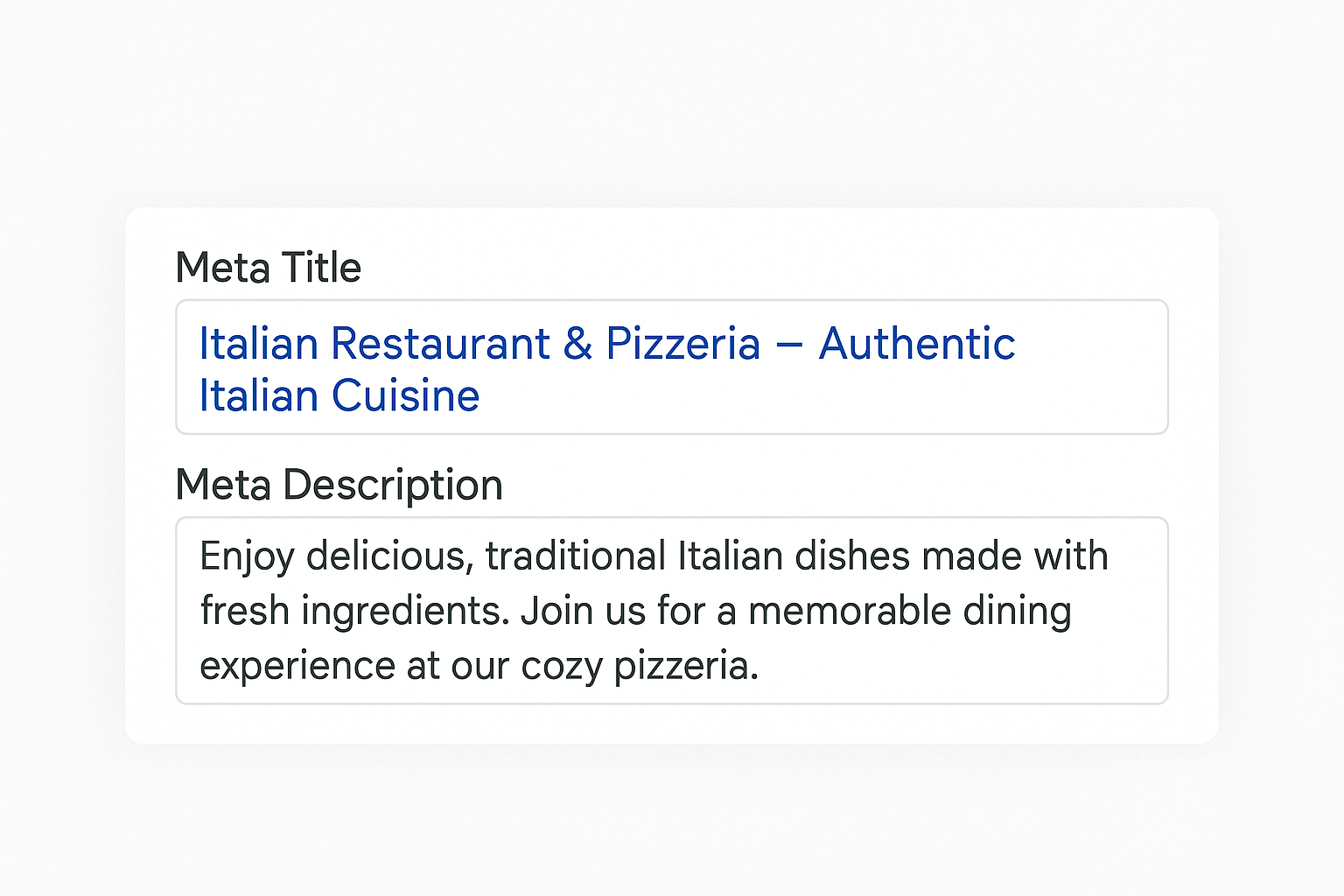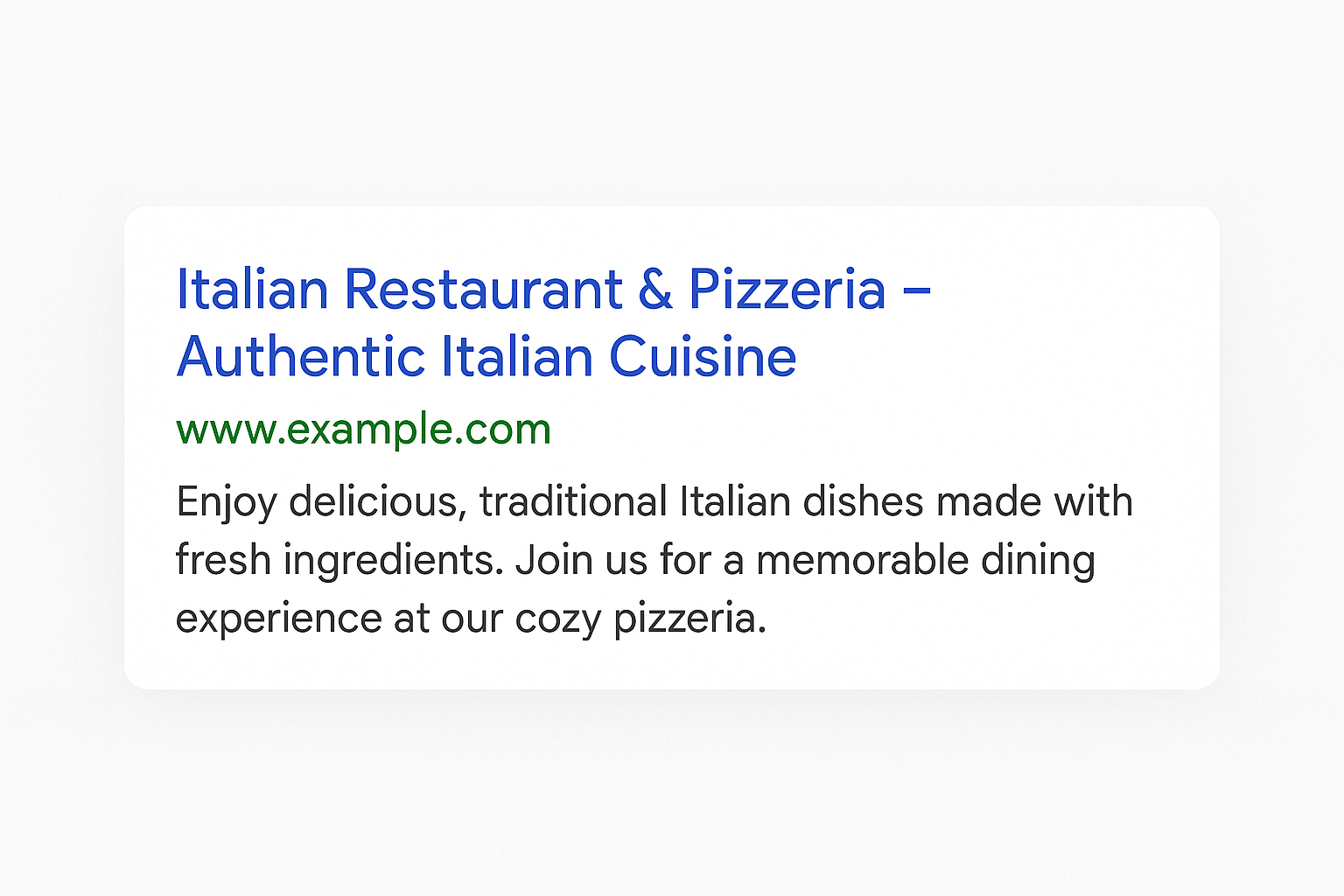
Table of Contents
- Key Takeaways
- What Meta Titles and Descriptions Actually Do
- What Makes a Good Meta Title?
- Writing Meta Descriptions That Convert
- Meta Tags That Help You Stand Out
Writing meta titles and descriptions isn’t just about adding keywords. It’s about making your first impression count for both search engines and the people doing the searching. A well-written title and description can influence whether someone clicks your link or chooses another result.
At Texas Web Design, we’ve helped businesses turn search visibility into real conversions by improving these small but powerful elements. If you’re ready to get better results and more qualified traffic, contact us today and let’s work together on building meta content that performs.
Here’s how you can write meta titles and descriptions that grab attention, align with search intent, and encourage clicks that lead to real action.
Key Takeaways
- Meta titles and descriptions are the first thing users see in search results. They set expectations and influence click behavior.
- A good title should include your main keyword early, stay under 60 characters, and align with the content of your page.
- Meta descriptions should be 150 to 160 characters, give clear value, speak to user intent, and include a natural call to action.
- Titles and descriptions affect both SEO rankings and conversions. Improving them can lead to more qualified traffic and better engagement.
- Testing and refining meta tags can uncover small changes that increase visibility and clicks over time.
- If you need help improving your SEO strategy, Texas Web Design can create meta content that attracts the right audience and delivers results.
What Meta Titles and Descriptions Actually Do

Think of them as a handshake or quick preview. They help people decide whether to visit your page or move on.
You could write great content and still be overlooked if your meta tags aren’t strong. The title draws users in. The description gives them a reason to click.
Search Engine Visibility
Search engines rely on meta titles and descriptions to understand the content of your page. This helps determine which queries your page appears for in search results. For titles, keep the length under 60 characters, use your main keyword early, and clearly describe what the page offers.
Here’s an example:
Title: Affordable Yoga Mats for Beginners | Shop Online
Description: Discover eco-friendly yoga mats perfect for beginners. Fast shipping and 10 percent off today.
This setup helps both search engines and users immediately understand the topic and value of the page.
On the other hand, vague or irrelevant tags can lead to lower rankings, even if your actual page content is helpful. Clear and relevant meta tags help ensure your content appears in front of the right audience.
How People Respond Before Clicking
Meta tags don’t just help with rankings. They shape how users perceive your page in a sea of search results. Your goal is to meet their expectations and give them a reason to click.
someone searches for “Top Pizza Spots in Dallas,” here’s how you might approach your meta tags:
Title: Best Pizza Restaurants in Dallas | Dine or Takeout
Description: Try award-winning pizza at popular local spots. Reserve your table today.
This speaks directly to what the searcher is looking for, offers value, and includes a gentle prompt to take action.
Getting your tags right builds trust before the visitor even reaches your website.
From Search to Action
Attracting users is one part of the process. Motivating them to take the next step is another.
For example, if your meta description says, “20 percent Off All Dog Beds. Shop Today,” you’re offering value and urgency. That makes clicking more appealing.
In contrast, a description like “We sell many sizes of dog beds” doesn’t give people much to react to. The right wording in your meta content can support the decision-making process and help turn visits into conversions.
What Makes a Good Meta Title?
Your meta title affects your position in search results and whether people click on your link. To be effective, it needs to be clear, aligned with your content, and thoughtfully written.
Match the Page Topic

People want to know what to expect before clicking.
Use Your Main Keyword
Place your focus keyword close to the beginning of the title. If you’re targeting “SEO tips for small businesses,” write a title that includes that exact phrase.
Better: SEO Tips for Small Businesses | Texas Web Design
Weaker: Grow Online With These Insights | Marketing Tips
The second version sounds broad and unclear, while the first is direct and relevant to the search.
Stay Within Character Limits
Search engines usually cut off titles longer than 60 characters. Focus on the most valuable words and avoid fluff. Every character counts, so make sure the message is complete and easy to understand at a glance.
Use Words That Connect With People
Phrases like “Easy,” “Save,” or “Avoid” speak to people’s goals and concerns. They make your titles feel more personal. For example, “How to Save $200 a Month on Groceries” is clear, helpful, and gets attention without being exaggerated.
Writing Meta Descriptions That Convert
Your meta description is your chance to explain what someone will find on your page. You have about 150 to 160 characters to work with, so make it count. It should add context, highlight a benefit, and make the user want to click.
Be Clear and Relevant
Don’t simply restate your title. Use the description to expand on the topic or offer a benefit. If you’re selling phone cases, avoid saying something vague like “We sell great phone cases.” That doesn’t help the user.
Better: “Shop durable, stylish phone cases with free 2-day shipping.”
It’s direct, descriptive, and gives the user a reason to visit.
Speak to the Search Intent
Think about what the user actually wants. If someone searches for “cheap home office chairs,” your meta should reflect that interest.
Example: “Explore ergonomic office chairs under $150. Free returns included.”
Use your keywords naturally, and don’t force them in. Keep the focus on how your content solves a problem or meets a need.
Add a Call to Action

Here are a few that work well:
- Shop now
- Learn more
- Get yours today
- Compare features
- Browse top picks
Example: “Find your perfect gaming laptop today. Compare specs and prices now.”
The idea is to make the next step feel easy and worthwhile.
Meta Tags That Help You Stand Out
Strong meta titles and descriptions help your content appear higher in search results and give users a reason to choose your link over others. It’s a small part of your SEO strategy that can make a big difference.
Once your tags are in place, keep refining them. Try different calls to action. Test new language. Watch your performance over time. Small improvements can lead to better results and a stronger connection with your audience.
Many site owners overlook their meta tags, thinking they’re too small to matter. But getting them right can improve both traffic quality and user behavior.
If you’re looking for help creating stronger SEO content, Texas Web Design is here to support you. Our team focuses on writing copy that gets seen, earns clicks, and drives real action.
Call us today and let’s improve how your website shows up and performs in search results.

